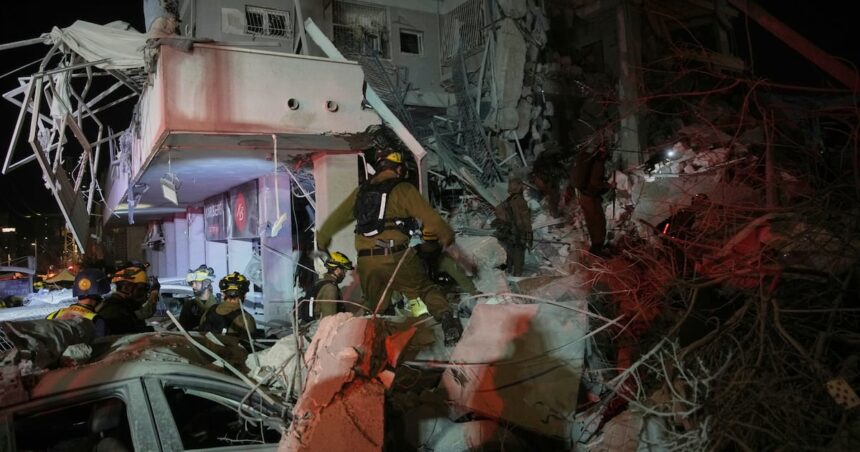The night sky over Tehran erupted in flames around 2:30 AM local time as Israeli F-35 stealth fighters delivered precision strikes against Iran’s Defense Ministry headquarters. The attack marked a dramatic escalation in the ongoing shadow war between the two Middle Eastern powers, coming just hours after Iran launched approximately 180 missiles toward Israeli military installations.
Standing on the rooftop of my hotel in Tehran’s northern district, I witnessed the orange glow illuminate the pre-dawn darkness. Air raid sirens wailed across the capital as Iran’s air defense systems attempted to intercept the incoming Israeli warplanes. “We heard the explosions and thought it was thunder at first,” said Mariam Karimi, a 34-year-old teacher who lives three kilometers from the targeted facility. “Then the building shook, and we knew it was something much worse.”
According to the Iranian Revolutionary Guard Corps (IRGC), the Israeli strike targeted the nerve center of Iran’s defense establishment, damaging several buildings within the complex and causing at least 14 casualties. Iranian state television showed footage of firefighters battling blazes at the compound while emergency services transported the wounded to nearby hospitals.
The Israeli military acknowledged the operation several hours later, with IDF spokesperson Rear Admiral Daniel Hagari stating the attack was “a proportional response to Iran’s unprovoked missile barrage against Israeli sovereign territory.” Defense Minister Gideon Sa’ar emphasized that Israel had targeted “military infrastructure only” and had taken precautions to minimize civilian casualties.
This dramatic exchange represents the most serious direct military confrontation between the two adversaries since tensions began escalating in early 2024. What makes this round particularly concerning is the abandonment of the previous “gray zone” approach where both sides maintained plausible deniability through proxy forces and covert operations.
“We’re witnessing the collapse of strategic ambiguity,” explained Dr. Nader Hashemi, Director of Middle East Studies at Georgetown University, whom I interviewed via encrypted call as military aircraft continued to patrol overhead. “Both countries are now engaging in open warfare, which dramatically increases the risk of regional conflagration.”
The missile exchange capped weeks of intensifying rhetoric following the assassination of Hamas political leader Ismail Haniyeh in Tehran last month—an operation widely attributed to Israeli intelligence. Iran’s Supreme Leader Ayatollah Ali Khamenei had vowed “severe revenge” for the killing, which occurred during Haniyeh’s visit to attend the inauguration of Iran’s new president.
At the United Nations Security Council emergency session convened last night, representatives from Russia and China condemned Israel’s “disproportionate response,” while U.S. Ambassador Linda Thomas-Greenfield urged both sides to exercise restraint while defending Israel’s right to self-defense. European nations called for immediate de-escalation, with France’s representative warning of “catastrophic regional consequences” if the conflict continues to intensify.
Oil markets reacted immediately, with Brent crude jumping 8% to $112 per barrel in early Asian trading—the highest level since 2022. Analysts at Goldman Sachs warned that any disruption to shipping in the Strait of Hormuz, through which approximately 20% of global oil supplies pass, could push prices beyond $150.
Walking through Tehran’s Tajrish Bazaar this morning, I found stores shuttered and streets nearly deserted. “People are staying home, waiting to see what happens next,” said Abbas Mohammadi, one of the few shopkeepers who opened his dried fruit stall. “We have lived with threats for decades, but this feels different.”
The Israeli operation appears to have been carefully calibrated to destroy specific military capabilities while avoiding targets that might trigger all-out war. Intelligence sources speaking on condition of anonymity revealed that Israel had communicated through backchannels that the strike would be limited to military installations directly connected to Iran’s missile program.
According to the International Institute for Strategic Studies, Iran possesses the largest and most diverse missile arsenal in the Middle East, with some systems capable of reaching targets throughout Israel and beyond. Yesterday’s Iranian missile salvo demonstrated both the strengths and limitations of these capabilities—while most missiles were intercepted by Israel’s multi-layered air defense systems, several penetrated and struck military facilities in the Negev desert.
Iran’s Foreign Minister immediately condemned Israel’s overnight strikes as “an act of war” and promised further retaliation. Meanwhile, the Pentagon confirmed that the USS Abraham Lincoln carrier strike group has been redirected toward the Persian Gulf, and additional F-22 fighter squadrons are being deployed to bases in Qatar and the United Arab Emirates.
Regional allies find themselves in increasingly precarious positions. Saudi Arabia and the UAE, which have both pursued rapprochement with Iran in recent years while maintaining security ties with Israel, called for “maximum restraint” and offered to mediate. Jordan closed its airspace temporarily, while Lebanon’s Hezbollah movement—Iran’s most powerful regional proxy—placed its forces on high alert.
For ordinary Iranians, already struggling with inflation exceeding 45% and tightening international sanctions, the military confrontation brings new anxieties. “We are caught between our government’s policies and others’ reactions,” said Zahra Ahmadi, a university student I met at a Tehran coffee shop. “The people always pay the highest price.”
As night falls again in Tehran, the city braces for potential further strikes. Military vehicles patrol major intersections, and civil defense officials have advised residents to identify nearest shelters. Meanwhile in Tel Aviv, similar preparations are underway as Israel’s Home Front Command has activated emergency protocols across the country.
With diplomatic efforts faltering and military posturing intensifying, the prospect of wider regional war looms larger than at any point in recent memory. The coming days will determine whether this dangerous escalation can be contained or if the Middle East stands at the precipice of a conflict that could reshape the regional order for decades to come.






